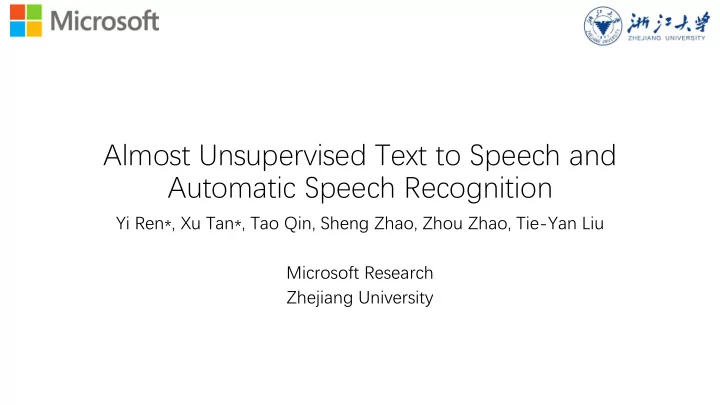

Almost Unsupervised Text to Speech and Automatic Speech Recognition Yi Ren*, Xu Tan*, Tao Qin, Sheng Zhao, Zhou Zhao, Tie-Yan Liu Microsoft Research Zhejiang University
Motivation • ASR and TTS can achieve good performance given large amount of paired data. However, there are many low-resource languages in the world that are lack of supervised data to build TTS and ASR systems. • We propose a practical way to leverage few paired data and additional unpaired speech and text data to build TTS and ASR systems.
Model Architecture
Denoising Auto-Encoder • We adopt denosing auto-encoder to build these capabilities. (Green and yellow lines) • Representation extraction: how to understand the speech or text sequence. • Language modeling: how to model and generate sequence in speech and text domain. DAE (Speech) DAE (Text) I xx a boy. I am a boy.
Dual Transformation • Dual transformation is the key component to leverage the dual nature of TTS and ASR, and develop the capability of speech-text conversion. TTS (inference) ASR (inference) I am a boy. I love ASR ASR (train) TTS (train) I am a boy. I love ASR
Bidirectional Sequence Modeling • Sequence generation suffers from error propagation problem , especially for the Speech sequence, which is usually longer than text. • Due to dual transformation, the later part of the sequence is always of low quality. • We propose the bidirectional sequence modeling (BSM) that generates the sequence in both left-to-right and right-to-left directions. TTS (train) ASR (train) I am a boy. I am a boy. TTS (train) ASR (train) yob a ma i yob a ma i
Audio Samples Printing then for our purpose A further development of may be considered as the art of the Roman letter took Text making books by means of place at Venice. movable types. Paired- 200 Our method
Results Our Method : leverages 200 paired data + 12300 unpaired data Pair-200 : leverages only 200 paired data Supervised : leverages all the 12500 paired data GT : the ground truth audio GT (Griffin-Lim) : the audio generated from ground truth mel-spectrograms using Griffin-Lim algorithm
Results The higher, the better The smaller, the better • Our method only leverages 200 paired speech and text data, and additional unpaired data • Greatly outperforms the method only using 200 paired data • Close to the performance of supervised method (using 12500 paired data)
Thanks!
Experiments • Training and evaluation setup • Datasets • LJSpeech contains 13100 audio clips and transcripts, approximately 24 hours. • Evaluation • TTS: Intelligibility Rate and MOS (mean opinion score) • ASR: PER (phoneme error rate)
Analysis • Ablation Study on different components of our method
Analysis The smaller, the better The higher, the better 3 80 70 2.5 60 2 50 40 1.5 30 1 20 0.5 10 0 0 MOS (TTS) PER (%) (ASR)
Recommend
More recommend